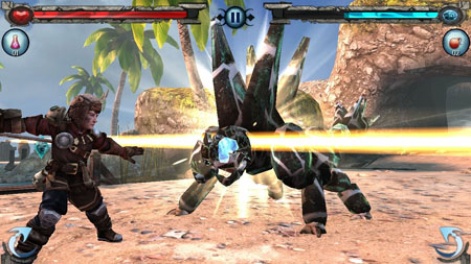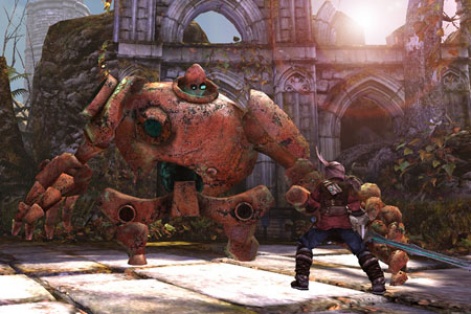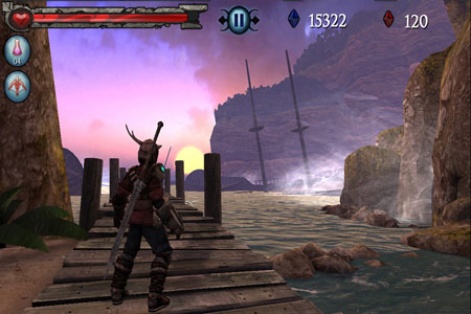Staffed by veterans of console and PC development, it's already built a reputation for itself delivering narrative-heavy action-adventure titles on mobile with sumptuous graphics and accessible gameplay.
The most recent of these is Horn, released in August 2012 in a publishing deal with Zynga.
We caught up with creative director Chip Sineni to find out how the game came about, the difficulty in bringing console-like titles to mobile, and the lure of freemium.
Pocket Gamer: Unusually for a mobile game, Horn highly story-oriented. What were your inspirations?
Chip Sineni: Horn is very much inspired by iconic console games such as Zelda, Tomb Raider, Uncharted, and Ico - action adventure games that tie storytelling with puzzle solving.

There really isn't any of that on mobile, so we wanted Horn to fill that void.
What was it about those games that appealed to you and what were the challenges of bringing the experience to mobile?
The main things were the controls and how much disk space we would need to use.
In terms of controls, we really wanted to have a scheme optimised for touchscreens - make it simple enough that anyone could pick it up and play - but still have plenty of depth. We have some refinements we'd like to add to take it even further, but we think we have one of the better solutions for maintaining flexibility with accessibility.
In terms of disk space, we had to be clever with how we reuse environments and worlds - still, the game is close to 2GB of pure content!
What do you mean about taking the controls further?
Something we'd love to do, is keep the controls we have, but add layers. An example is: you keep touching to move, but if you keep your finger pressed down, it could work as a forward button for players who want more nuanced controls - you then release to stop moving.
We have lots of ideas we'd like to add, but they all have other ramifications in terms of how the game works, so we have to be careful about adding stuff until it is thoroughly tested.
You explored similar territory with 2011's Dark Meadow. How did that influence Horn?
Much of Horn is based from things we wanted to evolve from Dark Meadow.
For combat, we got rid of the queue-based combat where you have to wait your turn to do damage to an enemy.

We added 360-degree combat to make it more dynamic and to allow for different vantage points around enemies. We added breakable armour and added weak points on enemies. We also added free movement and puzzle solving - all stuff we wanted in Dark Meadow.
Dark Meadow took three months to make. Was Horn's development time similar?
For Horn, we spent about five months prototyping with the design team, then another six months with the whole team. It has been a much bigger effort.
What development tools did you use?
We use Unreal Engine for console and PC games, so it is a natural choice for us on mobile.
It's the only engine that allows us to hit the art bar we want, as well as allowing us to prototype (and ship) with a lot of design-based game systems - many of the advanced navigation and all of the puzzles are set up by design, as opposed to programmers.
It just makes for a smarter way to make games.
When you start a project, how formal are you in terms of design documents etc?
We tend to do a lot of design by prototypes and keep refining the vision. We try to make the prototypes as quickly as possible, iterate further on the promising ones, and throw out the ones that don't immediately click.
An example of this is originally we had enemies moving all about the world, but it was really hard to navigate and fight them at the same time.
How did your partnership with Zynga come about and how did it affect Horn's development?
Zynga has been a great partner to work with.
Horn was mostly complete when the partnership solidified, so it didn't have much initial input. However, from the beginning, it understood what the game was about and what type of audience the game was made for. It never suggested something that wasn't right for the game.
Your previous history is with console games, so what advantages and disadvantages have you encountered moving to mobile?
At Phosphor we tend to look at how we make stuff 'big' - how we can blow out mobile to be more like PC and console?

But doing this within a mobile budget can be hard. The Legend of Zelda: Skyward Sword had a large team spending more than three years to polish an iterative sequel, whereas we had a very small team working for six months trying to compete.
Horn's graphics are an obvious highlight. How important do you feel high-end visuals are in attracting potential consumers?
Visuals in PC and console games work as a motivation to play more, or to see what is coming next. On mobile, with a story-based game, we are trying to do something similar and make the player always curious what cool thing is up ahead.
What aspects of the game are you particularly proud of?
We are all proud that we made such an epic action adventure game for mobile devices.
There really is nothing else like it, and it originally seemed like it would be impossible to do because of the challenges and stigma that mobile couldn't handle it.
What do you identify as the game's biggest weakness?
As developers we tend to be the hardest on our creation. We shipped with version 1.0 of the controls, but as developers we wished we hit version 3.0. Also, because of how little time we had, we couldn't see the whole game and its pacing until very late.
We were originally worried the game would only be 5-6 hours long, but it ended up more like 14-18 hours long. We would have rather have had a shorter game that was tighter, with more unique puzzles, but we just didn't know what we had until too late.
Many players don't get to the last third of the game, which is our favourite part.
Finally, we shipped a bit early. The game played much better after a patch that added stability and checkpoints everywhere. These made the levels much easier to pick-up-and-play and not lose your progress.
You've just released Horn for Android, what are the challenges of that process?
There are a lot of Android devices. We wish we could support them all, but it just takes a lot of time.
Nvidia makes it the easiest with its awesome Tegra chips. If all Android devices had them, you'd see a lot more cool games available for all Android devices.

However, if anyone wants Horn on their Android device and it isn't available, request it on our Facebook. If enough people want it, we'll get it to that device.
How has Horn performed?
Horn has had a really good start for us. The reviews are very favourable, and it seems to be resonating.
The challenge is getting it to have a longer tail and attract the people who missed the launch to check it out.
Dark Meadow was initially a premium priced game, but made the jump to free. How did that affect both the game's revenue and the pricing model you adopted for Horn?
We haven't disclosed revenue numbers, but Dark Meadow went over the million downloads total a couple months back. As a developer, it's really cool to know that many people checked out your game.
But we went premium for Horn because we didn't feel there was a way (with the time we had) to figure out a free-to-play monetisation model that worked with the story and puzzle-solving aspect.
Can you make Horn free-to-play?
The way the story and puzzles work, right now we don't think there is an applicable free-to-play monetisation model. BUT we would like to get it into as many hands as possible, as the price can scare off a lot of users.
As PC and console gamers, we're used to shelling out $60 for a game, so it is crazy to us that people balk at a $6 game - it's the price of a fast food meal - but that is the reality of the market.
Are you looking at the freemium model for your next project?
Freemium is impossible to ignore, and I would generally recommend it to every mobile developer. However, we do think there is still a place for premium games. Gameloft, in particular, has shown that established and quality IP can sell.
With that said, we are working on multiple mobile titles right now, and we are trying out different pricing models that make sense for these projects.
So what's next for Phosphor?
We can't say, but right now mobile and PC space look very cool...
Thanks to Chip for his time.
You can check out Horn for iOS here [iTunes link] and Android here [Google Play link], priced $6.99 or local equivalent.





















